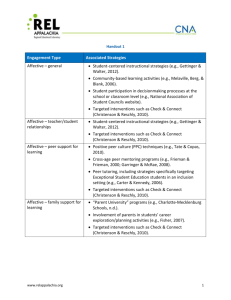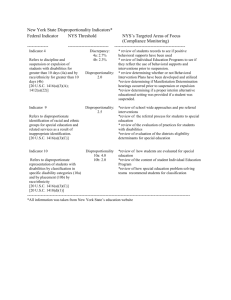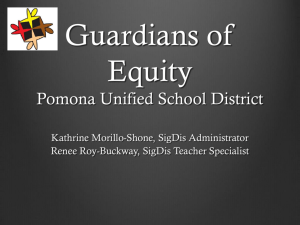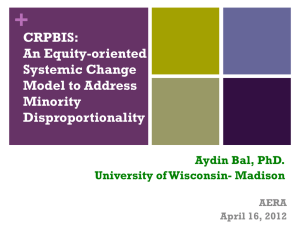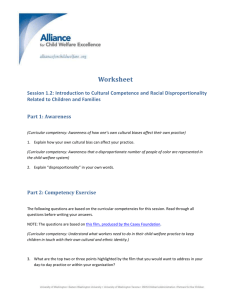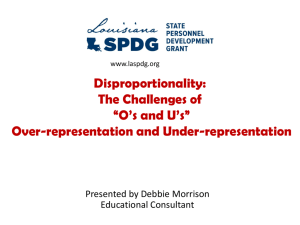IA Disproportionality-Prevention Reading-Behavior
advertisement
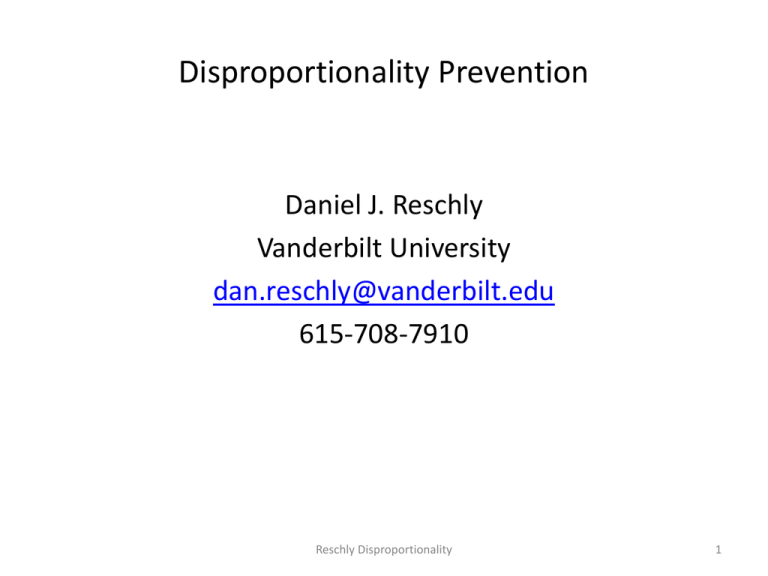
Disproportionality Prevention Daniel J. Reschly Vanderbilt University dan.reschly@vanderbilt.edu 615-708-7910 Reschly Disproportionality 1 National Academy of Science Panel Report • Donovan, M. S., & Cross, C. T. (Eds) (2002). Minority students in special and gifted education. Washington, DC: National Academy Press. • “There is substantial evidence with regard to both behavior and achievement that early identification and intervention is more effective than later identification and intervention.” (Donovan & Cross, 2002, p. 6). Reschly Disproportionality 2 Discipline and Special Education Referrals • What leads to discipline referrals and suspension/expulsion • What leads to special education referral, disability identification, and special education placement? • Discussion Reschly Disproportionality 3 • • • • • • • • Discussion 1. 2. 3. 4. 5. 6. 7. Reasons for referrals Reschly Disproportionality 4 Analysis of Reading Results • National Assessment of Educational Progress (NAEP) – Nation’s Report Card Reading (2011) http://nces.ed.gov/nationsreportcard/pdf/main2 011/2012457.pdf – Biennial examination of US achievement in selected areas (reading, mathematics, science, history, etc.) – Generally administered at 4th and 8th grades – Samples of students from each state – Rigorous standards-more rigorous than state standards for proficiency Reschly Disproportionality 5 NAEP 2009 Descriptions of Achievement Categories • Categories – < Basic: Less than partial mastery of prerequisite knowledge and skills fundamental to proficient work at the grade level – Basic: Partial mastery of …….. – Proficient: Solid academic performance. Demonstrated competency over challenging subject matter – Advanced: Superior performance National Center for Educational Statistics (2009). (NCES 2010458). Institute of Educational Sciences, US Department of Education, Washington DC. Reschly Disproportionality 6 USA NAEP 2011 4TH Grade Reading by Group 100% 90% 80% 70% 60% 50% 40% 30% 20% 10% 0% 4 15 30 17 32 2 16 32 2 14 33 50 21 32 2 9 1 6 21 23 34 36 30 51 10 2 16 51 68 48 70 Advanced Proficient Basic < Basic 23 Notes: SES=Socioeconomic Status; SWD=Students with Disabilities; Reschly Disproportionality ELL=English Language Learner 7 IA groups differ significantly in reading outcomes IA groups generally are below USA averages 70 NAEP 4TH Grade Reading for Iowa Groups 62 60 51 52 50 50 40 30 32 30 32 2728 33 35 32 33 32 27 20 17 13 16 14 10 10 2 1 2 < Basic Basic Proficient 24 23 21 34 32 Advanced 13 10 10 2 0 USA Asian IA Asian USA IA Black USA IA Hisp USA IA Black Hisp White White Reschly Disproportionality 8 20 Change in NAEP 4th Grade Reading Standard Score: 1992-2011 by State 15 10 US Median Change=5 IA Change= -4 5 0 ME IA AK NM WI -5 SD IN MO MN ID NE AZ IL OR WV ND UT WY NH KS MI VT MT TN CT OK AR CO NV NY NJ WA CA GA MS HI MA DE KY AL DC RI SC LA PA OH NC TX USA VA Reschly Disproportionality FL MD 9 20 NAEP Standard Score Changes by State 1992-2011 4TH Grade Reading 15 10 US Median Gain=5 IA Change= -4 0 -5 ME AK IA NM WI SD WV IN MO ND UT VT MN WY ID NE NH AZ IL KS MI MT TN OR USA CT OK RI SC TX VA AR CO LA PA NV NY OH NJ WA CA GA NC MS HI MA DE KY AL DC FL MD 5 Reschly Disproportionality 10 USA and IA 2011 NAEP 4TH Grade Reading Results 6 7 Advanced 27 25 Proficient Basic 35 34 < Basic 31 34 0 10 IA Total USA-Total 20 Reschly Disproportionality 30 40 11 240 NAEP 4th Grade Reading Standard Scores 1992-2011 237 236 234 235 234 231 230 225 228 226 225 225 223 223 223 221 220 220 215 223 217 215 212 216 220 221 220 221 220 217 USA IA MA 213 210 IA one point above USA average 205 200 Year 1992 1994 1998 2002 2003 2005 2007 2009 2011 Reschly Disproportionality 12 Explanation: Why did MA improve and IA decline? Why do IA minorities perform lower than USA Averages? Discussion? 1. 2. 3. 4. 5. 6. Reschly Disproportionality 13 NAEP 4th Grade Reading Standard Scores 1992-2011 240 MD from 211 to 231 FL from 208 to 225 AL from 207-220 235 IA 230 225 225 210 205 200 223 220 220 215 223 USA 215 211 208 207 212 210 208 205 213 212 211 206 217 214 223 219 218 216 221 220 219 217 MD 231 FL 225 224 226 225 USA 220 221 220 221 220 AL 216 216 IA FL MD 207 207 208 AL 1992 1994 1998 2002 2003 2005 2007 2009 2011 Reschly Disproportionality 14 What did Alabama do that Iowa did not do? Can IA do as well as AL in reading? Ideas? Reschly Disproportionality 15 NAEP 4th Grade Reading % Proficient and Advanced 1992-2011 55 50 45 Year 1992 1994 1998 2002 2003 2005 2007 2009 2011 51 49 47 47 44 40 35 40 36 30 25 20 27 36 35 28 28 23 24 20 IA Rank 2 15 35 33 6 35 30 35 30 36 33 30 20 22 21 22 20 22 21 8 17 19 18 Reschly Disproportionality 32 29 24 10th 34 32 28 24 23 33 32 31 USA AL IA MA NV 26 27 16 Iowa Population Characteristics Demographics? Is that a credible explanation? 1. Does Iowa have a higher proportion of students who have lower NAEP scores? 2. Other IA population characteristics? Reschly Disproportionality 17 2009 Overall Poverty Rates and Proportions of Students Age 5-17 in Poverty Circumstances Digest of Educational Statistics (2011, Table 26, p. 48) 30 27 IA poverty rate below US average 25 20 15 19 19 17 14 16 1112 15 12 10 11 10 % Poverty % Poverty 5-17 5 0 USA AL IA MA FL Reschly Disproportionality MD 18 2008 Composition of Student Populations by Race/Ethnicity Digest of Educational Statistics 2011 (Table 43) 90 80 70 60 50 40 30 20 10 0 84 70 59 55 55 55 37 35 22 17 1 5 USA 11 4 AL 12 67 IA 0 14 58 26 17 02 MA FL 0 AI/Ak As/PI Black Hispanic White 4 4 MD Iowa is less diverse than the US and selected states Reschly Disproportionality 19 USA AND IA 4TH Grade Reading Results for Asian/Pacific Islander Students 35 30 30 27 32 32 USA A/PI Students Outperform IA A/PI Students 28 25 21 20 17 15 13 USA Asian IA Asian 10 5 0 < Basic Basic Proficient Reschly Disproportionality Advanced 20 70 USA AND IA 4TH Grade Reading Results 62 for Black Students 60 50 USA Black Students Outperform Iowa Black Students 51 40 33 USA Black IA Black 27 30 20 14 10 10 2 1 0 < Basic Basic Proficient Advanced Reschly Disproportionality 21 60 50 USA AND IA NAEP 4TH Grade Reading Results 52 for Hispanic Students 50 USA and IA Hispanic Students Perform at Similar Levels 40 32 33 30 20 16 USA Hisp IA Hisp 13 10 2 2 0 < Basic Basic Proficient Advanced NAEP Reading Proficiency Level Reschly Disproportionality 22 USA AND IA NAEP 4TH Grade Reading Results for White Students 40 35 34 35 32 32 USA and IA White Students Perform at Similar Levels 30 25 23 24 USA White IA White 20 15 10 10 10 5 0 < Basic Basic Profic Reschly Disproportionality Advan 23 USA AND IA NAEP 4TH Grade Reading Results for Students with Disabilities 90 78 80 70 68 60 50 USA-SWD IA-SWD 40 30 21 20 15 10 9 6 0 < Basic Basic 2 1 Proficient Advanced Reschly Disproportionality 24 From IA DOE Report Reschly Disproportionality 25 USA AND IA NAEP 4TH Grade Reading Results for English Language Learner Students 80 70 70 65 60 50 USA-ELL IA-ELL 40 30 23 28 20 6 7 10 0 < Basic Basic Proficient Reschly Disproportionality 1 0 Advanced 26 Explanations: Can Something Be Done? Reschly Disproportionality 27 What did MD, FL, AL and other states with large NAEP gains do? Reschly Disproportionality 28 Importance of Prevention • “ There is substantial evidence with regard to both behavior and achievement that early identification and intervention is more effective than later identification and intervention.” Nat’l Academy Report on Disproportionality p. 5 • “If antisocial behavior is not changed by the end of grade 3, it should be treated as a chronic condition much like diabetes. That is, it cannot be cured, but managed with the appropriate supports and continuing intervention.” (Walker et al., 1995, p. 6) Reschly Disproportionality 29 Snow re reading (slightly paraphrased) Reading intervention with a 2nd grader is like changing the direction on a speedboat, with a 5th grader it is like changing the direction of an oil tanker. (Ed Week May 13, 2009, p.11 Reschly Disproportionality 30 Importance of Scientifically Based Reading Instruction Reading is a gateway competence. Referrals to special education are dominated by students with reading problems. Reading competence is related to several important educational outcomes. Science of reading instruction Chall, 1967, 2000; National Reading Panel, 2000; Snow, Burns, and Griffin, 1998 Florida Center for Reading Research (http://www.fcrr.org/) The University of Texas at Austin, Vaughn Gross Center for Reading and Language Arts (http://www.texasreading.org/utcrla/) Science of reading instruction markedly underutilized 31 Use of Course Syllabi • Common practice across disciplines • Syllabus is a contract • Examine all courses in teacher education regarding IC components, not just a single course • Limitations of Syllabi – Incomplete reflection of course content and activities – Difficult to judge depth of experiences – Some content on syllabus not taught and some content is taught that is not on the syllabus • Overall: Syllabi reflect major features of program 32 WWW.tqsource.org Next Steps: Adopt scientifically-based reading instruction Reading Curricula content-Snow et al, 1998 Scientifically-based instruction Phonemic Awareness Phonics Fluency Vocabulary Comprehension PLUS Direct, systematic, sequential instruction Universal screening and formative evaluation Problem of teacher preparation VU-TQ Center Innovation configurations, reading, classroom behavior, inclusive services, learning strategies (Reschly, et al., 2007) Reschly Disproportionality 33 Snow, C. E., Burns, M. S. & Griffin, P. (Eds.) (1998). Preventing reading difficulties in young children. Washington DC: National Academy Press. National Reading Panel. (2000). Teaching children to read: An evidence-based assessment of the scientific research literature on reading and its implications for reading instruction. Washington, DC: National Institute of Child Health and Human Development. Reschly Disproportionality 34 Chall, J. .S. (1967). Learning to read: The great debate. New York: McGraw-Hill. •Research review 1900-1965 •Early Reading, K-3 •Code vs Meaning Emphasis •Phonics or Whole Word •Code superior, especially for struggling readers Lamented the generally poor Preparation of teachers to teach reading Reschly Disproportionality 35 Standards and Curriculum • Establish standards that specify appropriate reading content • Adopt reading curricula aligned with standards and reading content • Develop assessments aligned with standards and curriculum • Establish progress monitoring formative assessments • Develop summative mechanisms with consequences to teachers, schools, and individual students Reschly Disproportionality 36 IMPROVE TEACHER PREPARATION: PRE-SERVICE AND CPD IHEs and SBRI Five Components 80 Source National Council on Teacher Quality http://www.nctq.org/ Sample N=72 70 60 5 Components • Phonemic awareness • Phonics • Fluency • Vocabulary • Comprehension # of Components Taught Well 50 43% 40 N=31 30 20 15% 11% 7% N=11 N=8 10 N=5 11% 13% N=8 N=9 2 1 0 5 4 Reschly Reschly Disproportionality 3 0 37 37 Iowa Institutions of Higher Education (IHE) in Walsh et al. 2006 Study Three Iowa IHEs Included: Number of reading components taught well Institution Walsh et al Score Buena Vista University 4 for 5 University of Iowa 0 for 5 University of Northern Iowa 1 for 5 Other 0 for 5 IHEs, U of MN, Ill State, U of NC Reschly Disproportionality 38 Centrality of Teachers and Teacher Preparation Teacher effects are significant, especially for at-risk students and students with disabilities. Tennessee Value Added Assessment System: Three years of highly effective teachers overcome effects of low socioeconomic status Teacher qualifications (e.g., degree level) have trivial effects Teacher practices have large effects. Research-based teaching practices exist but are not taught in most teacher preparation programs. Improved teacher preparation and professional development are prerequisites to improved achievement. Reschly Disproportionality 39 Preparation of Special Education Teachers in Scientifically-Based Reading Instruction in 27 IHEs (Reschly et al., 2007) 100 90 80 70 60 % 50 40 30 20 10 0 SI EI PA SBRR NCLB Principles FL Progress Monitoring V C Phonics Inadequate Most Integration Reschly Disproportionality Universal Screening 40 Reading Course Syllabi: Projects 1. Explain your philosophy of literacy. 2. Develop a bulletin board to motivate children to read. 3. Produce journal explaining your personal experience in learning to read. 4. Analyze the social justice implications of literacy 5. Describe the hegemony of western white males on modern literacy Reschly Disproportionality 41 Instruction and Reading • “Currently our children experience a wide range of disparate experiences that jumble together and end up requiring our youngest learners to figure them out on their own. Our children are not failing to learn. Our schools are failing to teach them effectively.” (Foundation for Child Development, 2008, America’s Vanishing Potential: The Case for PreK-3rd Education.) • See also Early warning! Why reading by the end of third grade matters (2011). Baltimore, MD: Anne E. Casey Foundation. Downloaded June 30, 2011, http://www.aecf.org/~/media/Pubs/Initiatives/KIDS%20COU NT/123/2010KCSpecReport/AEC_report_color_highres.pdf Reschly Disproportionality 42 Some things do not make sense Reschly Disproportionality Reschly Behavior 43 43 Improve Teacher Preparation in Reading • Align teacher preparation program approval standards with scientifically based reading curricula (CO, MA, AL, MD) • Adopt rigorous reading content and instruction test for teacher education graduates (MA, MN, WI) • Continuing professional development in readingleverage Iowa Reading First expertise?? (MA, AL, FL) • Require current teachers pass rigorous reading test as incentive for advanced status or, perhaps, for continuation of license in grades K-8 Reschly Disproportionality 44 Reading Innovation Configuration (Smartt & Reschly, 2007) • Define what should be taught in teacher preparation to ensure evidence based practices • Innovation configuration: Two dimensional tables – Vertical dimension: Critical reading content with indicators – Horizontal dimension: Level of implementation • Innovation configurations in reading, mathematics, classroom organization and behavior management, direct instruction, learning strategies, inclusion practices, response to intervention Reschly Disproportionality 45 Smartt, S. M., & Reschly, D. J (2007). Barriers to the preparation of highly qualified teachers in reading. Washington DC: National Comprehensive Center on Teacher Quality. http://www.tqsource.org/ publications/June2007Brief.pdf Reschly & Wood-Garnett (2009) Teacher Prep and RTI at Middle and High Schools http://www.tqsource.org/ publications/September200 9Brief.pdf Reschly Disproportionality 46 SBRI Innovation Configuration Reading Innovation SeeConfiguration Handout (with examples) Key Essential Component None Code = 0 Mention Only Code = 1 Mention Plus Readings/ Tests Code = 2 Plus Assignments Code = 3 Plus Supervised Practice Code = 4 Phonemic Awareness Examples Speech sounds, no letters Precursor to phonics Segmenting, blending, manipulating phonemes (sounds) ex. /b/ /a/ /t/ =bat Reschly Disproportionality 47 Reading absent examples SBRIInnovation InnovationConfiguration Configuration, cont. In each area See Handout Key Essential Component None Code = 0 Mention Only Code = 1 Mention Plus Readings/ Tests Code = 2 Plus Assignments Code = 3 Plus Supervised Practice Code = 4 Phonics Fluency Vocabulary Comprehension Systematic Instruction Explicit Instruction Universal Screening & Progress Monitoring Reschly Disproportionality 48 Apply Reading IC to Course Syllabi • Examine 2 course syllabi • Apply the Principles of Scientifically-based Reading Instruction • Use Reading IC and Syllabi Reschly Disproportionality 49 Differences and Implications • Differences 1. 2. 3. 4. 5. 6. Reschly Disproportionality 50 Rigorous Assessment of Students’ Reading Development • Universal Screening beginning Fall Kindergarten (examples follow) • Curriculum-based measures, beginning in Fall of Kindergarten through 8th grade • Reference CBM results to goals using benchmarks above national norms • Examine results by classroom, school, and district; • Identify students below benchmarks early, intervene early when interventions are less expensive and more effective • Rigorous nationally standardized tests to compare performance to national standards, with a reading scale tied to NAEP Reading Reschly Disproportionality 51 Purposes of Universal Screening • Assess success of instructional program – Percent of students at or above benchmarks – If necessary, examine curriculum, instruction, or both • Identify students below benchmarks – Interventions within general education classroom – Assess progress and consider need for more intensive interventions at Tier II 52 WWW.tqsource.org Tier I: Assessment: Academics Academics Academics: Screen all students, begin in kindergarten; 3 times per year with appropriate early literacy and math measures More intense instruction and monitoring within classroom for students below trajectories toward passing state benchmark tests and increase assessment to 2 Xs per month Consider use of paraprofessionals (Pat Vadasy at U of WA) in screening and delivery of interventions Reschly Disproportionality 53 Universal Screening Results • Assess success of instructional program – Percent of students at or above benchmarks – If necessary, examine curriculum, instruction, or both • Identify students below benchmarks – Interventions within general education classroom – Assess progress and consider need for more intensive interventions at Tier II Reschly RTI 54 Common Benchmarks Benchmark is lowest level to still have an 80% probability of passing high stakes reading tests Age/Grade Measure Fluency (FL) Letter Naming Fl Initial Sound Fl Criterion Spring KTG Phoneme Seg 35 sounds pm Winter 1st gr. Spring 1st gr. Spring 2nd gr. Spring 3rd gr. Nonsense WD Oral Rdg Fluency Oral Rdg Fluency Oral Rdg Fluency 50 sounds pm 40 wds pm 90 wds pm 110 wds pm Winter KTG Reschly 25 sounds per minute (pm) 55 Benchmarks Vary By State: Minneapolis Data and State of MN High Stakes Test Cumulative Percent: Passing 3rd Grade State Test 100% 95% 90% 85% 80% 75% 60 wpm 80% pass test 70% 65% 60% 55% 50% Number of Words Read Correctly per Minute Spring of First Grade Reschly 56 Consequences of Not Meeting Tier I Goals • Upside down • Overload Tier II and Tier III • Low probability of passing high stakes reading tests • Markedly reduced likelihood of high school completion and post-secondary educational and career participation Reschly 57 Analysis of Results • • • • Do we really need graphs? Don’t our teachers know who is behind? Why look at the entire class? Do results in classrooms and with different teachers really vary that much? • Upside down tiers: more students need Tier II than are successful in Tier I Reschly 58 Classroom 1: Initial Sound Fluency Fall to Winter KTG: Correct Sounds per Minute 65 55 Benchmark=25 45 35 35 Fall 27 23 25 17 15 15 17 15 11 Winter 21 18 17 16 19 11 9 5 56 6 6 7 7 17 9 12 5 1 1 1 1 1 2 2 3 3 -5 1 2 3 4 5 6 7 8 9 10 11 12 13 14 15 16 17 Reschly Disproportionality 59 Classroom 2: Initial Sound Fluency Fall to Winter KTG: Correct Sounds per Minute Instruction Matters 65 Benchmark=25 64 64 55 43 45 38 35 25 15 5 -5 21 28 27 26 25 25 24 32 27 21 18 22 24 24 Fall 26 Winter 19 6 6 6 7 7 5 5 4 4 13 1 1 2 3 3 3 3 3 3 11 14 1 2 3 4 5 6 7 8 9 10 11 12 13 14 15 16 17 18 27 20 21 Reschly Disproportionality 60 Classroom 1: Correct Phoneme Segmentation per Minute Winter to Spring Kindergarten 75 70 65 60 55 50 45 40 35 30 25 20 15 10 5 0 Benchmark=35 58 54 53 49 45 35 32 30 25 1 5 1 1 5 2 23 8 10 1 13 35 5 3 4 5 6 10 11 18 12 13 16 17 0 7 8 January 9 May Reschly Disproportionality 10 11 12 13 14 15 61 Classroom 2: Correct Phoneme Segmentation per Minute Winter to Spring Kindergarten 75 70 65 60 55 50 45 40 35 30 25 20 15 10 5 0 75 Benchmark 56 57 70 74 74 68 60 56 67 63 56 51 46 46 22 10 11 74 47 47 74 74 66 69 57 58 59 54 51 50 42 40 38 38 18 16 14 25 26 23 21 1 1 2 3 4 5 6 7 8 9 10 11 12 13 14 15 16 17 18 19 20 21 22 January May Reschly Disproportionality Instruction Matters!! 62 Second Grade Oral Reading Fluency Benchmarks: Early 2nd=42 WCM; Winter=71 WCM End of 2nd=90 to 95 Good results? Poor results? Level is unsatisfactory. Progress is good. Consider results at early 2nd grade 120 100 80 ?? F W 60 40 20 0 1 3 5 7 Students needing greater Gen’l Ed monitoring and Interventions 9 11 13 Reschly Disproportionality 15 17 19 63 Hypothetical Iowa Goals and Hypothetical Results 4th Grade Reading Percent Proficient and Advanced 55 50 45 40 35 30 34 33 35 37 39 41 43 45 47 49 51 53 IA Goal Goal: Raise % Proficient and Advanced by 2% Per Year 25 Reschly Disproportionality 64 Behavior: Prevention? Discussion: What can be done to prevent behavior infractions that lead to suspension/expulsion and contribute to special education referrals? 1. 2. 3. 4. 5. Reschly Disproportionality 65 Multi-tiered Interventions Varying in Intensity and Measurement Precision Progression to higher and lower tiers determined by children’s RTI Tier III More intense, longer term interventions Decision Making Tier II: More Intense Academic and Behavioral Interventions Small group and individual interventions using PS and standard protoco Tier I: Core Program Academics and Behavior in General Education Effective core instruction Screening In basic academic skills School-wide PBIS COBM Teacher Assistance PS Reschly Behavior 66 Barriers to RTI Implementation? • Teacher knowledge of interventions • Intervention resources • Knowledge of methods to measure progress Reschly Disproportionality 67 Prevention of Behavior Problems • “If antisocial behavior is not changed by the end of grade 3, it should be treated as a chronic condition much like diabetes. That is, it cannot be cured, but managed with the appropriate supports and continuing intervention.” (Walker et al., 1995, p. 6) Reschly Disproportionality 68 Tier I: Screening for Behavior Problems • Early indications of later serious behavior problems appear by age 3-5 • Early identification-treatment more effective than later interventions, especially with aggression • Behavior referrals often occur too late for maximum effect of interventions • Identification as ED and Sp Ed placement most often occur at age 10, 11, or older when interventions are less effective and more resistant Tier 1 Screening Procedures • Proactive rather than reactive • Multiple respondents and settings • Earlier is better – i.e. preschool or kindergarten • Include multiple measures after initial teacher nominations/rankings – Direct observations, record reviews, parent ratings, other sources Kauffman, 2005 Systematic Screening for Behavior Disorders (SSBD) • Walker, H. M., & Severson, H. H. (1992). Systematic Screening of Behavior Disorders (SSBD). Longmont, CO: Sopris West. • Multiple “gating” procedure – Externalizing vs. internalizing • Identifying at-risk students grades 1-6 • Every child is screened in general education • Child must have been in classroom a minimum of 30 days to be screened Walker & Severson, 1992 Stage 1—Objectives • To provide standards, definitions, and criteria for teacher use • To provide structure for teachers to use in referring students • To reduce the likelihood that a particular student in need of services will not be referred • To give each student an equal chance Walker & Severson, 1992 SSBD Stage 1—Teacher Screening 1. Identify groups of students whose characteristic behavior patterns most closely match the internalizing and externalizing profiles 2. Rank order students in the two groups according to the degree or extent to which each one matches the behavioral profile in question Walker & Severson, 1992 SSBD Stage 1—Teacher Screening Step 1 • Select 10 students who most closely match each of the behavior profiles • Mutually exclusive—either/or not both Step 2 • Rank order **Three highest on each category pass Gate 1 Walker & Severson, 1992 Internalizing Items: Identify 10 students, then identify the 3 highest (SSBD, Walker & Severson, 1996) • • • • • • • • • Having low or restricted activity levels Not talking to other children Being shy, timid, and/or unassertive Avoiding or withdrawing from social situations Preferring to play or spend time alone Acting in a fearful manner Not participating in games or activities Being unresponsive to social initiations by others Not standing up for one’s self Externalizing Items: Identify 10 students, then identify the 3 highest (SSBD, Walker & Severson, 1996) • • • • • • • • • • • Displaying aggression toward objects or persons Arguing Forcing the submission of others Defying the teacher Being out of seat Not complying with teacher instructions or directives Having tantrums Being hyperactive Disturbing others Stealing Not following teacher- or school-imposed rules Pass Gate 1 SSBD Stage 2—Objectives • To describe the specific content of the behavior problems experienced by 3 highest ranked externalizing and internalizing students • To provide a basis for making normative comparisons on the checklists to determine whether student should be assessed at Stage 3 • To provide important information to determine eligibility for special services and designing effective interventions Walker & Severson, 1992 SSBD Stage 2—Teacher Rating Teacher completes 2 checklists: Critical Events Checklist for Externalizing and Internalizing Behavior (CEI) – 33 maladaptive behavioral indicators – Place a check next to any behavior exhibited one or more times Combined Frequency Index for Adaptive and Maladaptive Behavior (CFI) – 23 items measuring teacher-related and peer-to-peer behavior adjustment(s) using a continuous scale 1 – 5 – Estimates frequency in which each item occurs **Children exceeding normative criteria on CEI or CFI pass Gate 2 Walker & Severson, 1992 SSBD Pass Gate 2 SSBD Stage 3—Objectives • Verify or confirm the teacher’s ranking/ratings of student behavior in Stages 1 and 2 • Provide a direct measure of the 2 most important behavioral adjustments children are required to make (to teachers and peers) • Make it possible to assess the student’s normative level(s) in relation to classroom and peer adjustment areas Walker & Severson, 1992 SSBD Stage 3—Direct Observations • Classroom and playground settings • Can use non-referred, average student as a peer comparison • 2 observation sessions per setting (15-20 minutes each) • Observer is someone other than teacher (e.g., school psychologist, social worker) Walker & Severson, 1992 SSBD Stage 3—Direct Observations • Academic Engaged Time (AET) – The amount of time a student spends actively engaged in attending to and working on relevant academic material • Peer Social Behavior Observation (PSB) – Observations of social engagement, participation, parallel play, and alone ** Children exceeding normative criteria on AET and PSB pass Gate 3 Walker & Severson, 1992 SSBD Pass Gate 3 Behavioral Earthquakes Critical Behavioral Events High impact-great intensity-low frequency behaviors: Behavioral Earthquakes Fire setting, cruelty, extreme aggressiveness, suicide threats/attempts, physical confrontation, use of weapons, etc. Should provoke immediate referral School Archival Records Search (SARS)-Sopris Principles of Strong Classroom Organization and Management • • • • • • Engaging instruction Structuring the environment Monitoring behavior and academic engagement Classroom rules and behavioral routines Encourage and reinforce appropriate behavior Behavior reduction strategies • Oliver, R. M., & Reschly, D. J. (2007). Improving student outcomes in general and special education: Effective classroom management. Washington, DC: Learning Point Associates, National Comprehensive Center for Teacher Quality. http://www.tqsource.org/topics/effectiveClassroomManagement. pdf Reschly Behavior 88 Tier I: Behavior: Classroom Organization and Behavior Management http://www.cde.ca.gov/ls/ss/se/classroommgmt.as p Kellam, Baltimore Schools Students randomly assigned to 1st grade teachers, then classroom was the unit of analysis Classrooms observed during first 9 wks., high rates of disruptive behavior and aggression, large differences across classrooms Classrooms randomly assigned to, Experimental condition: Good Behavior Game (Barrish, et al, 1969; Sulzer-Azaroff & Mayer, 1991) vs. Control condition of in-service on general curriculum Reschly Behavior 89 issues Kellam Research: Classroom Organization and Management Good Behavior Game (Barrish, et al., 1969) Group contingency Two groups formed into teams Define rules and positive behaviors Teams compete for positive consequences Team with highest rate of appropriate behaviors earn “rewards” Lining up first, Help teacher pick-up classroom, free time, etc. Reschly Behavior 90 Kellam Research: Effects of Good Behavior Game Were Statistically Significant • Aggression and disruptive behavior continued in control classrooms • Marked reduction in experimental condition • Experimental classrooms had higher academic productivity and achievement • Aggressive students in both conditions followed through 6th grade and first grade classroom effects persisted • First grade experience sets academic and behavioral trajectory Reschly Behavior 91 Exp Agg Baseline Exp On task Exp Work Con Agg Con On Task Reschly Behavior GB 10 GB 9 GB 8 GB 7 GB 6 GB 5 GB 4 GB 3 GB 2 Good Beh 1 Baseline 4 Baseline 3 Baseline 2 Con Work Baseline 1 90 80 70 60 50 40 30 20 10 0 Good Behavior Game 92 Implications of Classroom Organization and Behavior Management • Classroom organization and behavior management are crucial to student success – “Teacher’s skills at classroom management were then critical to children’s socialization, particularly in the face of family poverty.” (Kellam, et al., 1998a, p. 182) – “Teacher training typically does not provide effective methods and experience in classroom behavior management.” (Kellam, et al., 1998, p. 182). • Bradshaw, C. P., Zmuda, J. H., Kellam, S. G., & Ialongo, N. S. (2009). Longitudinal impact of two universal preventive interventions in first grade on educational outcomes in high school. Journal of Educational Psychology, 101, 926-937. Reschly Behavior 93 Classroom Organization and Behavior Management • Classrooms vary significantly in organization and management • Influences engaged time and academic productivity • Influences incidence of behavior problems • Discipline issues: major cause for teacher attrition • Most new teachers to not believe they are adequately prepared, especially for classrooms with culturally diverse, economically disadvantaged students • Teacher preparation vs teacher needs Reschly Behavior 94 Classroom Organization and Behavior Management Innovation Configuration Reschly Disproportionality 95 Reschly Disproportionality 96 SBRI Innovation COBM InnovationConfiguration, Configuration cont. See Handout Key Essential None Mention Mention Plus Plus Component Code = 0 Only Code = 1 Readings/ Tests Code = 2 Assignment s Code = 3 Plus Supervised Practice Code = 4 Structured Environment • Daily schedule is posted and clearly visible to students. • Environment is arranged for ease of flow of traffic and distractions minimized. Reschly Disproportionality 97 SBRI Innovation COBM InnovationConfiguration, Configuration cont. See Handout Key Essential Component Active Supervision and Student Engagement Teacher scans, moves in unpredictable ways, and monitors student behavior. Teacher uses more positive than negative teacher-student interactions. Teacher provides high rates of opportunities for students to respond. Teacher utilizes multiple observable ways to engage students (e.g., response cards, peer tutoring). Reschly Disproportionality Reschly Disproportionality 98 98 SBRI Innovation COBM InnovationConfiguration, Configuration cont. See Handout Key Essential Component School-wide Behavioral Expectations • A few, positively stated behavioral expectations are posted, systematically taught, reinforced, and monitored. Classroom Rules • A few, positively stated behavioral rules are linked to school-wide expectations. • Rules are posted, systematically taught, reinforced, and monitored. Reschly Disproportionality Reschly Disproportionality 99 99 SBRI Innovation COBM InnovationConfiguration, Configuration cont. See Handout Key Essential Component Classroom Routines • Classroom routines are systematically taught, reinforced, and monitored within the context of the classroom (e.g., turning in homework, requesting assistance). Encouragement of Appropriate Behavior • Procedures acknowledge appropriate behavior at the group level (e.g., specific, contingent praise, tokens, activities, group contingencies, Good Behavior Game). • Procedures encourage appropriate behavior at the individual student level (e.g., specific, contingent praise; behavior contracts). • Data are collected on the frequency of appropriate behavior100 Reschly Disproportionality Reschly Disproportionality 100 within the classroom environment. SBRI Innovation COBM InnovationConfiguration, Configuration cont. See Handout Key Essential Component Behavior Reduction Strategies • Antecedent strategies are used to prevent inappropriate behavior (e.g., precorrection, prompts, environmental arrangements). • Multiple procedures are used to respond to inappropriate behavior. • Procedures are used to teach replacement behaviors and reteach appropriate behavior (e.g., overcorrection). • There is differential reinforcement (e.g., reinforcing other, competing behaviors). • There is effective use of consequences (e.g., planned ignoring, time-out from positive reinforcement, Reschly Disproportionality 101 Reschly Disproportionality 101 reinforcing around target student). Characteristics of Current Teacher Preparation Programs Re: Behavior Discussion 1. 2. 3. 4. 5. 6. Reschly Disproportionality 102 Proportion of University Syllabi with Evidence of Component vs. No Evidence (Oliver & Reschly, 2010) 100 80 46 35 38 58 50 81 60 % 100 40 54 20 65 62 42 50 19 0 0 code =Reschly 1-4 RTI code = 0 Reschly Disproportionality 103 103 Basic Problem Solving (Teacher and School Teams) • Define the Problem (Screening and Diagnostic Assessment) What is the problem and why is it happening? • Evaluate • Develop a Plan (Progress Monitoring Assessment) Did our plan work? (Goal Setting and Planning) What are we going to do? • Implement Plan (Treatment Integrity) Carry out the intervention Reschly Behavior Heartland AEA 11 104 Royal Kiss? Grace van Cutsem Not Impressed Enough Already: Time for me to sit down!! Reschly 105 Sense of Humor Three things that are real: God, human folly, and laughter; The first two are beyond our comprehension So we must do what we can with the third. John F. Kennedy Best wishes to you for a great convention and year

